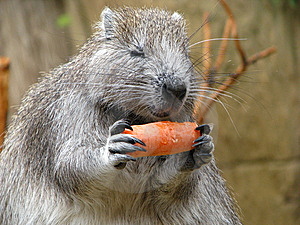
The jutía rata (Conga), a Cuban endemic species of rodent in “critical danger of extinction”, has disappeared from its unique habitat in Cayo Fragoso (central-north), after the devastating passage of Hurricane Irma in that area of the island, revealed this Friday scientists from the Caribbean country.
Before Irma there were 88 shelters of the species in the cay, located to the north of Caibarién, province of Villa Clara; but after an inspection at the “Lanzanillo Pajonal Fragoso” wildlife refuge, only two uninhabited ones were discovered, said Ernesto Hernández, the principal specialist in the protected marine-coastal area.
The Cuban jute (Capromys auritas) was threatened because of its location in a fragile dune and mangrove ecosystem.
Baptized by the fishermen of Caibarién due to its small size, the species owns a long tail almost with almost the same dimensions of its body, of about 28 centimeters and a weight of 1 to 1,5 kilograms.
Among its characteristics are an abundant and rough coat, as well as an elongated head with pointed ears.
Hernandez added that a large number of birds such as pelicans, “corúas” and herons, along with scraps and traces of iguanas and the threatened jute conga (Capromys pilorides), were reported in the cayo, state newspaper Juventud Rebelde reported.
“We are hopeful that the other species (conga jutía) may have survived,” said the specialist, who said that they “systematically monitor the survival of some specimens, although the initial inspection made a bad omen when they did not check any indication of its presence “.
Cayo Fragoso also suffered damage to corals, sea grasses and sponges, a situation that could be repeated in the northern coast of the Cuban center.
This was the island territory most hit by Irma, which left 10 dead and significant economic damages after passing between the 8 and 10 September last.
In addition, the powerful hurricane affected more than 4,000 hectares of mangroves in the Caguanes National Park in the central province of Sancti Spiritus and eroded the beaches of eastern Havana.
Irma caused the death of about 500 flamingos in the seven stone keys that Caguanes has, and about three tons of fish.
Specialists in that protected area are currently reviewing the population of iguanas and other plantations harmed by the meteor.
LA JUTÍA CONGA CUBANA, EN PELIGRO DE EXTINCIÓN, DESAPARECE DESPUES DE HURACÁN IRMA.
La jutía rata (Conga), especie endémica cubana de roedor en “peligro crítico de extinción”, ha desaparecido de su único hábitat en Cayo Fragoso (centro-norte), tras el paso devastador del huracán Irma por esa zona de la isla, revelaron este viernes científicos del país caribeño.
Antes de Irma existían 88 cobijos de la especie en el cayo, situado al norte de Caibarién, provincia de Villa Clara; pero tras una inspección en el refugio de fauna “Lanzanillo Pajonal Fragoso”, solo se descubrieron dos deshabitados, informó el especialista principal de esa área marino-costera protegida, Ernesto Hernández.
La jutía rata cubana (Capromys auritas) se encontraba amenazada a causa de su localización en un ecosistema frágil de duna y manglar.
Bautizada por los pescadores de Caibarién debido a su tamaño reducido, la especie posee una larga cola casi con casi las mismas dimensiones de su cuerpo, de unos 28 centímetros y un peso de 1 a 1,5 kilográmos.
Entre sus características resaltan un pelaje abundante y áspero, además de una cabeza alargada con orejas terminadas en punta.
Hernández agregó que sí apreciaron en el cayo una gran cantidad de aves como pelícanos, “corúas” y garzas, junto a desechos y rastros de iguanas y la amenazada jutía conga (Capromys pilorides), publicó el diario estatal Juventud Rebelde.
“Estamos esperanzados en que quizás haya podido sobrevivir la otra especie (jutía conga)”, afirmó el especialista, quien aseguró que realizan “un monitoreo sistemático para verificar si sobrevivieron algunos ejemplares, aunque la inspección inicial realizada dejó un mal augurio al no comprobar ningún indicio de su presencia”.
En Cayo Fragoso también sufrieron daños los corales, los pastos marinos y las esponjas, situación que podría repetirse en la cayería norte del centro cubano.
Éste fue el territorio isleño más azotado por Irma, que dejó 10 muertos y cuantiosas afectaciones económicos tras su paso entre el 8 y el 10 de septiembre últimos.
Además, el potente huracán afectó a más de 4.000 hectáreas de manglares del Parque Nacional Caguanes, en la provincia central de Sancti Spiritus, y erosionó las playas del Este de La Habana.
Irma provocó la muerte de unos 500 flamencos en los siete cayos de piedra con que cuenta Caguanes, y de unas tres toneladas de peces.
Los especialistas de esa zona protegida revisan actualmente la población de iguanas y otras plantaciones perjudicadas por el meteoro.
Agencies/EFE/Internet Photos/YouTube/Arnoldo Varona/TheCubanhistory.com
THE CUBAN HISTORY, HOLLYWOOD.






